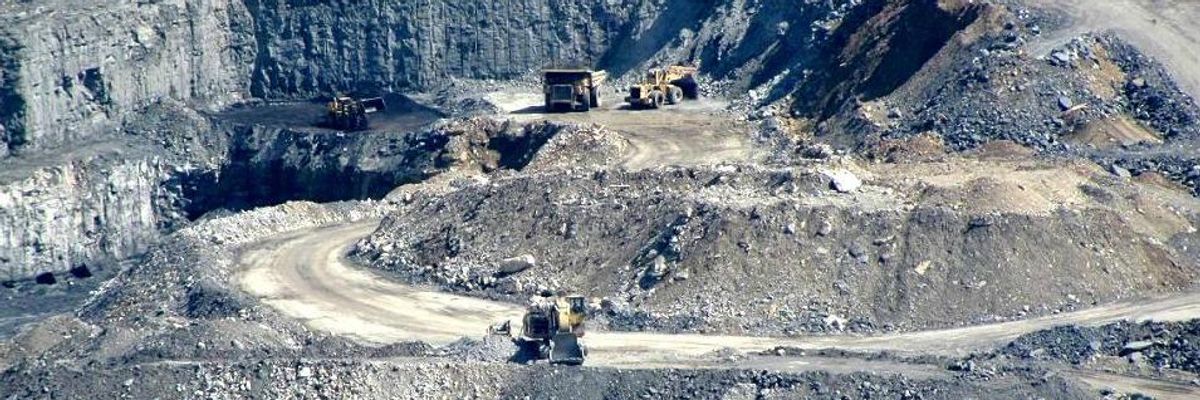"It's time that the political games end and that we pass the ACHE Act, end mountain top removal coal mining and protect Appalachians from this concerted attack on our lives for coal. The supporters of mountain top removal and the non-supporters of the ACHE Act are beginning to look like the true heartless people that they are."
-- Maria Gunnoe, Environmental Organizer, Boone County, W.Va., 2012 University of Michigan Wallenberg Medal Recipient
Imagine that explosions rattle the community in which you have lived all your life. Toxic emissions spew into the air and settle into the water supply. The streams in which you fish are obliterated by rock and rubble. You worry that your children will die prematurely from cancer or brain tumors. You pray that the nearby containment tank will not breach and spill into your water supply its billions of gallons of poisonous coal waste.
This scenario illustrates the living nightmare of mountaintop removal coal mining for the people of Appalachia. "When growing up, I thought that all Appalachian children could run through the woods wild and free like I did," said West Virginia native Cary Reed. "Now several communities feel like a war zone with daily blasting. All children should grow up playing outside and not worry about breathing the air or drinking the water."
Big coal is killing Appalachia, its land and its people, not just figuratively, but literally. Coal companies are blowing the tops off of the Appalachian Mountains to reach the thin seams of coal buried below. This mountaintop removal process is despoiling one of the America's most precious natural resources, polluting the air and water, and creating a gulag of hazardous waste dumps.
The best way to halt the destruction of Appalachia and its people is through federal passage of the Appalachian Community Health Emergency Act, known as the ACHE Act. This legislation places a moratorium on new mountaintop removal permits and the expansion of existing permits until the Department of Health and Human Services completes a study to determine whether such mining operations pose a health threat to people living nearby.
Despite its stunning impact on the environment and people of the states of Kentucky, West Virginia, Virginia and Tennessee, the state and federal governments only minimally regulate and mountaintop removal coal mining. According to a 2009 study by Appalachian Voices, such mining had already destroyed more than 500 mountains, covering 1.2 million acres of land, about equal to the land mass of Delaware. More than 2,000 miles of streams have been buried under rock and rubble.
Even before mountaintop removal begins, topsoil and trees are stripped from the blasting area. Data from the Environment Protection Agency indicates that as of 2012, 1,200 square miles of forests will be cleared for mountain top removal mining.
Mountaintop removal coal mining also produces toxic emissions that have fouled the air and water of Appalachia. The result is a clear and present danger to the health of the people in this region of America.
Mining operators store vast quantities of toxic waste in impoundment tanks that can slowly leach into the human water supplies or create dangerous spills. On Jan. 9, 2014, some 7,500 gallons of toxic chemicals spilled from a containment tank into the Elk River, contaminating the water supply for hundreds of thousands of people in the metropolitan area of Charleston, W.Va. This disaster may represent only the tip of a hazardous iceberg. According to the U.S. Geological Survey, there are some 1,000 coal slurry impoundment sites in Appalachia, "each containing from tens of thousands to billions of gallons of coal slurry."
Studies have documented the human health risks of pollutants produced by mountaintop removal coal mining. A study accepted in October 2014 for Environmental Science and Technology experimentally traced the mechanism whereby particulate matter released into the air by such mining operations (termed PMMTM) are linked "to tumor growth of human lung carcinoma H460 cells." The authors conclude with this grim warning: "As more than 60,000 cancer cases has been estimated to correlate with MTM [mountaintop mining] activities in West Virginia, this finding on the cancer promoting effect of PMMTM and related epidemiological data are crucial to raise public health awareness to reduce cancer risk."
The health hazards of mountaintop removal mining extend beyond lung cancer. Researchers at West Virginia University and the U.S. Geological Survey concluded that Appalachian residents living near such mining operations "have higher rates of diseases, including cardiovascular, cardiopulmonary, lung, kidney, and respiratory diseases" than those in non-mining Appalachian areas.
"Those of us living (and dying) in mountaintop removal communities need no more research to tell us mountaintop removal is killing us," said Bo Webb, director of the ACHE Act campaign. "We need the United States Congress to urgently pass the ACHE Act, and protect our children from breathing any more of these deadly toxins. Short of that, anyone opposing the ACHE Act is exposing themselves as facilitating the commission of a crime against The People of Appalachia."
Politicians fear to act because of the myth that mountaintop removal coal mining produces essential jobs for the Appalachian region. Yet this process is so profitable in part because it requires relatively small numbers of workers. Mountaintop removal mining is one of the many contributing factors to plummeting coal jobs in the region. Since 1982, the number of coal-related jobs has fallen by about 70 percent in Kentucky and West Virginia.
The time is now to stop mountaintop removal mining. Otherwise, the coal companies will likely exploit the land to the hilt and then melt away into the night, leaving behind a devastated landscape, polluted air and water, and ticking time bombs of toxic waste impoundment sites. We should not forget that Freedom Industries, the company that owned the breached storage tank that contaminated the Charleston water supply, filed for bankruptcy about a week after the disaster, minimizing liability for its actions and leaving the people with no recourse.
